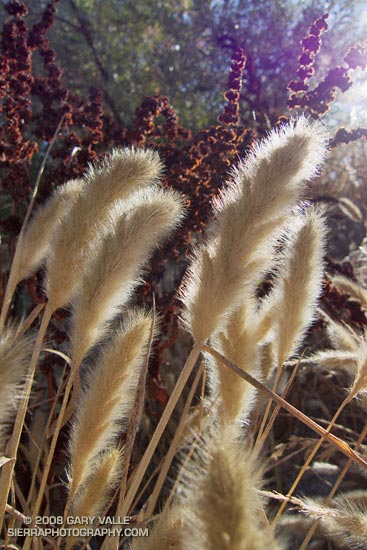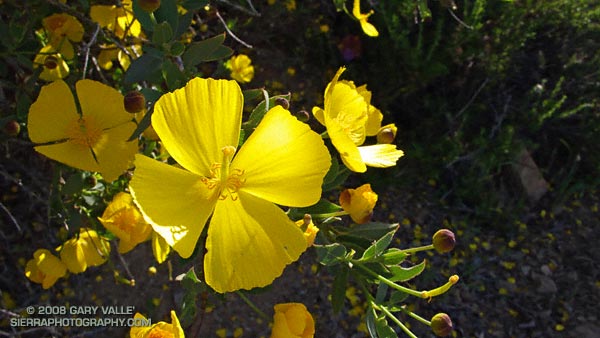
Rabbitfoot grass (Polypogon monspeliensis) along a vernal stream course in East Las Virgenes Canyon in Upper Las Virgenes Canyon Open Space Preserve (formerly Ahamanson Ranch).
This grass is not native to California. From a run in October.

Rabbitfoot grass (Polypogon monspeliensis) along a vernal stream course in East Las Virgenes Canyon in Upper Las Virgenes Canyon Open Space Preserve (formerly Ahamanson Ranch).
This grass is not native to California. From a run in October.

Tree poppy (Dendromecon rigida) on Temescal Ridge Fire Road, on the way to the Hub in Topanga State Park.
From a run in March of the Will Rogers – Temescal Loop in the Santa Monica Mountains.

There are some imperfections, but generally the unopened disk florets comprising the head of this immature sneezeweed blossom are arranged so that each floret is surrounded by six other florets. This is an example of hexagonal close packing, and is probably the most dense arrangement of florets that can be achieved in this spherical flower head.
The photograph of the Bigelow’s sneezeweed (Helenium bigelovii) was taken on an out and back run on the Pacific Crest Trail from Vincent Gap to Little Jimmy Spring during July 2007.
Related post: Bigelow’s Sneezeweed & Bee

Plumed achenes of curl-leaf mountain mahogany (Cercocarpus ledifolius) on the Chumash Trail. From Tuesday’s run.

Prickly poppy (Argemone munita) in upper Cheeseboro Canyon.
From today’s run of the Cheeseboro Canyon keyhole loop, starting from the Victory trailhead of Upper Las Virgenes Canyon Open Space Preserve (formerly Ahmanson Ranch).
Here’s a Google Earth image of a GPS trace of the loop, and links to trail maps for Upper Las Virgenes Canyon Open Space Preserve and Cheeseboro/Palo Comado Canyons.

There is yellow, and then there is the YELLOW of the mariposa lily, Calochortus clavatus. Remarkable in its brightness and purity, its yellow is one of the most intense and vibrant concentrations of color I have seen in the chaparral.
It is relatively uncommon, and this is one of a few seen along trails in Rocky Peak Park, and the Simi Hills. Of the varieties listed in the Jepson Manual, this appears most similar to the slender mariposa lily (Calochortus clavatus var. gracilis).
The insect emerging from the flower is a small bee — probably a species of Perdita (Andrenidae). These bees were found on several of the mariposa blossoms along the trail. They were usually near the gland near the base of each petal, and partially hidden by the club-like hairs that gives the species its name.
From a run earlier this week in Rocky Peak Park.
Related posts: Mountain Mariposa, Plummer’s Mariposa Lily